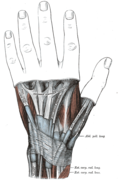- The mucous sheaths of the tendons on the back of the wrist. (Extensor indicis proprius visible going into second digit.)
- Bones of left forearm. Posterior aspect.
- Posterior surface of the forearm. Deep muscles.
- Transverse section across the wrist and digits.
- Extensor indicis muscle
- Extensor indicis muscle
- Extensor indicis muscle
- Extensor indicis muscle
- Extensor indicis muscle
- Muscles of hand. Posterior view.
- Muscles of hand. Posterior view.
| Extensor indicis proprius | |
|---|---|
 | |
 Posterior surface of the left forearm. Deep muscles. Extensor indicis muscle is labeled in purple. | |
| Details | |
| Origin | Posterior distal third of ulna and interosseous membrane |
| Insertion | Index finger (extensor hood) |
| Artery | Posterior interosseous artery |
| Nerve | Posterior interosseous nerve |
| Actions | Extends index finger, wrist |
| Identifiers | |
| Latin | musculus extensor indicis |
| TA98 | A04.6.02.052 |
| TA2 | 2515 |
| FMA | 38524 |
| Anatomical terms of muscle | |
In human anatomy, the extensor indicis (proprius) is a narrow, elongated skeletal muscle in the deep layer of the dorsal forearm, placed medial to, and parallel with, the extensor pollicis longus. Its tendon goes to the index finger, which it extends.










